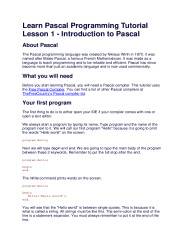Learn Pascal Programming Tutorial
This complete course progressively introduces the basics of programming. The support language is Pascal and the development environment chosen by the author is Lazarus.
In the first part are gathered useful notions to introduce before starting properly the course of programming. The following sections are devoted to subroutines, control structures, tables, structured types, and files, respectively.
Table of contents
- Lesson 1 - Introduction to Pascal
- About Pascal
- What you will need
- Your first program
- Compiling
- More commands
- Using commands from units
- Comments
- Lesson 2 - Colors, Coordinates, Windows and Sound
- Screen coordinates
- Windows
- Sound
- Lesson 3 - Variables and Constants
- What are variables?
- Using variables
- Calculations with variables
- Constants
- Lesson 4 - String Handling and Conversions
- Lesson 5 - Decisions
- if then else
- Case
- Lesson 6 - Loops
- For loop
- While loop
- Repeat until loop
- Break and Continue
- Lesson 7 - Arrays
- Sorting arrays
- Lesson 8 - Types, Records and Sets
- Lesson 9 - Procedures and Functions
- Global and Local variables
- Functions
- Lesson 10 - Text Files
- Lesson 11 - Data Files
- Lesson 12 - Units
- Lesson 13 - Pointers
- What is a pointer?
- Declaring and using typed pointers
- Lesson 14 - Linked Lists
- What is a linked list
- Single linked lists
- Queues
About Pascal
The Pascal programming language was created by Niklaus Wirth in 1970. It was named after Blaise Pascal, a famous French Mathematician. It was made as a language to teach programming and to be reliable and efficient. Pascal has since become more than just an academic language and is now used commercially.
What you will need
Before you start learning Pascal, you will need a Pascal compiler. This tutorial uses the Free Pascal Compiler. You can find a list of other Pascal compilers at TheFreeCountry's Pascal compiler list.
Your first program
The first thing to do is to either open your IDE if your compiler comes with one or open a text editor.
We always start a program by typing its name. Type program and the name of the program next to it. We will call our first program "Hello" because it is going to print the words "Hello world" on the screen.
program Hello;
Next we will type begin and end. We are going to type the main body of the program
between these 2 keywords. Remember to put the full stop after the end.
program Hello;
begin
end.
The Write command prints words on the screen.
program Hello;
begin
Write('Hello world');
end.
You will see that the "Hello world" is between single quotes. This is because it is what is called a string. All strings must be like this. The semi-colon at the end of the line is a statement separator. You must always remember to put it at the end of the line.
| Size : | 274.011 Kb |
| File type : | |
| Downloads: | 1257 |
| Created: | 2018-05-23 |
Warning: Trying to access array offset on false in /home/tutovnfz/public_html/article.php on line 233
Others Pascal Tutorials
Others related eBooks about Learn Pascal Programming Tutorial
HelloWorld Java Program free PDFDownload free course HelloWorld Java Program free PDF, pdf file on 3 pages by tutorialkart.com....
Learning with Python: How to Think Like a Computer ScientistThe user-friendly, object-oriented programming language Python is quickly becoming the most popular introductory programming language for both students and instructors....
Practical Artificial Intelligence Programming in JavaThis book uses both best of breed open source software and the author's own libraries to introduce the reader to Artificial Intelligence (AI) technologies like genetic algorithms, neural networks, expert systems, machine learning, and statistical natural language processing (NLP)....
A Python Book: Beginning Python, Advanced Python, and Python ExercisesDownload ebook Python tutorial, Python exercices, free PDF course by Dave Kuhlman....
The Common Java CookbookThis book focuses on tactical implementation details, answering such questions as: How do we parse XML? How do we serialize beans?...
The Boost C++ LibrariesThis book is an introduction to the Boost C++ Libraries. The Boost C++ Libraries complement the C++ standard and add many practical tools that can be of use to any C++ developer and in any C++ project. Because the Boost C++ Libraries are based on the C++ standard, they are implemented using state-...
Basic OOP in JavaThis tutorial you will learn the basics of Object-Oriented Programming in Java including class ,methods ,construcstors with some examples....
Become an Xcoder: Start Programming the Mac Using Objective-C...
Asynchronous Programming SuccinctlyDownload free course Asynchronous Programming Succinctly, pdf file on 85 pages by by Dirk Strauss....
Learning Laravel by examplesWith this PDF tutorial you will learn how to build a web application with Laravel PHP Framework version 4, free training document under 58 pages....
